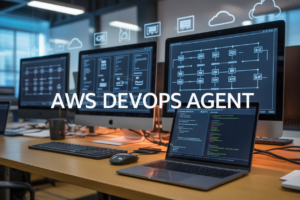Are you drowning in a sea of containers, struggling to keep your applications afloat? 🌊 Kubernetes might just be the life raft you need! This powerful container orchestration platform has revolutionized the way we deploy, scale, and manage applications. But let’s face it: mastering Kubernetes can feel like trying to tame a wild octopus 🐙 – with tentacles reaching into every aspect of your infrastructure.
Fear not, aspiring container wranglers! Whether you’re a DevOps engineer, a system administrator, or a curious developer, this guide will be your compass in the vast ocean of Kubernetes. We’ll navigate through the fundamentals, set sail towards practical deployments, and explore the advanced features that will make your containerized applications run smoother than a well-oiled machine.
Ready to embark on your Kubernetes journey? Buckle up as we dive into the essentials of deploying, scaling, and managing containers like a true professional. From understanding the core concepts to implementing best practices in production environments, we’ll cover everything you need to transform from a Kubernetes novice to a container orchestration maestro. Let’s set course for Kubernetes mastery! 🚀
Understanding Kubernetes Fundamentals
A. What is Kubernetes and why it matters
Kubernetes, often abbreviated as K8s, is an open-source container orchestration platform that automates the deployment, scaling, and management of containerized applications. It has become the de facto standard for container orchestration, revolutionizing the way modern applications are developed and deployed.
- Key features of Kubernetes:
- Automated container deployment
- Horizontal scaling
- Self-healing capabilities
- Load balancing
- Service discovery and DNS management
- Rolling updates and rollbacks
Kubernetes matters because it addresses critical challenges in modern application development:
| Challenge | Kubernetes Solution |
|---|---|
| Complex deployments | Automated, declarative deployments |
| Resource utilization | Efficient scheduling and bin packing |
| Application scalability | Horizontal scaling with ease |
| High availability | Self-healing and load balancing |
| Consistent environments | Infrastructure as code |
B. Key components of a Kubernetes cluster
A Kubernetes cluster consists of several essential components that work together to manage containerized applications:
-
Control Plane:
- API Server: The central management point
- Scheduler: Assigns workloads to nodes
- Controller Manager: Maintains cluster state
- etcd: Distributed key-value store for cluster data
-
Node components:
- Kubelet: Ensures containers are running on nodes
- Kube-proxy: Manages network rules for services
- Container runtime: Executes containers (e.g., Docker)
-
Add-ons:
- DNS: For service discovery
- Dashboard: Web-based UI for cluster management
- Ingress controller: For external access to services
C. Kubernetes architecture explained
Kubernetes follows a master-node architecture, where the control plane (master) manages the worker nodes. This design enables scalability, resilience, and separation of concerns.
Setting Up Your Kubernetes Environment
Choosing the right Kubernetes distribution
When setting up your Kubernetes environment, selecting the appropriate distribution is crucial. Several options are available, each with its own strengths:
- Vanilla Kubernetes: Official, highly customizable
- OpenShift: Enterprise-ready, with added security features
- Rancher: User-friendly interface, multi-cluster management
- Minikube: Ideal for local development and testing
| Distribution | Best for | Key Features |
|---|---|---|
| Vanilla K8s | Customization | Flexibility, Community support |
| OpenShift | Enterprise | Security, CI/CD integration |
| Rancher | Ease of use | GUI, Multi-cluster management |
| Minikube | Development | Local testing, Low resource usage |
Installing and configuring kubectl
kubectl is the command-line tool for interacting with Kubernetes clusters. To install:
- Download kubectl for your OS
- Add kubectl to your PATH
- Verify installation with
kubectl version
Configure kubectl to connect to your cluster:
- Obtain cluster configuration file
- Set KUBECONFIG environment variable
- Use
kubectl configcommands to manage contexts
Creating your first Kubernetes cluster
With kubectl ready, it’s time to create your cluster. Options include:
- Local: Minikube or kind
- Cloud: GKE, AKS, or EKS
- On-premises: kubeadm or kubespray
For beginners, Minikube offers a straightforward setup:
- Install Minikube
- Run
minikube start - Verify with
kubectl cluster-info
Exploring Kubernetes dashboard
The Kubernetes dashboard provides a web-based UI for cluster management. To access:
- Deploy dashboard:
kubectl apply -f https://raw.githubusercontent.com/kubernetes/dashboard/v2.7.0/aio/deploy/recommended.yaml - Create admin user and role binding
- Start proxy:
kubectl proxy - Access dashboard at http://localhost:8001/api/v1/namespaces/kubernetes-dashboard/services/https:kubernetes-dashboard:/proxy/
The dashboard offers insights into cluster health, workloads, and resources, making it an invaluable tool for both beginners and experienced users.
Deploying Applications on Kubernetes
Creating and managing Pods
Pods are the smallest deployable units in Kubernetes. They encapsulate one or more containers, storage resources, and network configurations. Here’s how to create and manage Pods effectively:
-
Pod Creation:
- Use YAML files to define Pod specifications
- Apply the configuration using
kubectl apply -f pod.yaml - Verify creation with
kubectl get pods
-
Pod Management:
- Monitor Pod status:
kubectl describe pod <pod-name> - Access Pod logs:
kubectl logs <pod-name> - Execute commands inside a Pod:
kubectl exec -it <pod-name> -- /bin/bash
- Monitor Pod status:
| Operation | Command |
|---|---|
| Create Pod | kubectl create -f pod.yaml |
| List Pods | kubectl get pods |
| Delete Pod | kubectl delete pod <pod-name> |
Working with Deployments for scalable applications
Deployments provide declarative updates for Pods and ReplicaSets. They ensure a specified number of Pod replicas are running at all times, enabling easy scaling and rolling updates.
Key features of Deployments:
- Scaling: Adjust replica count with
kubectl scale deployment <name> --replicas=<count> - Rolling updates: Update container images without downtime
- Rollback: Revert to previous versions if issues arise
Example Deployment YAML:
apiVersion: apps/v1
kind: Deployment
metadata:
name: nginx-deployment
spec:
replicas: 3
selector:
matchLabels:
app: nginx
template:
metadata:
labels:
app: nginx
spec:
containers:
- name: nginx
image: nginx:1.14.2
ports:
- containerPort: 80
Apply this configuration to create a scalable nginx Deployment with three replicas.
Scaling and Managing Kubernetes Workloads
Horizontal Pod Autoscaling for dynamic scalability
Horizontal Pod Autoscaling (HPA) is a powerful feature in Kubernetes that automatically adjusts the number of pod replicas based on observed metrics. This ensures your application can handle varying loads efficiently.
To implement HPA:
- Define resource requests in your pod specification
- Create an HPA resource with target metrics
- Configure the Metrics Server in your cluster
Here’s an example HPA configuration:
apiVersion: autoscaling/v2beta1
kind: HorizontalPodAutoscaler
metadata:
name: myapp-hpa
spec:
scaleTargetRef:
apiVersion: apps/v1
kind: Deployment
name: myapp
minReplicas: 2
maxReplicas: 10
metrics:
- type: Resource
resource:
name: cpu
targetAverageUtilization: 50
Implementing rolling updates and rollbacks
Rolling updates allow you to update your application with zero downtime. Kubernetes gradually replaces old pods with new ones, ensuring continuous availability.
Key steps for rolling updates:
- Update your deployment’s image or configuration
- Apply the changes using
kubectl apply - Monitor the rollout status
| Command | Description |
|---|---|
kubectl rollout status deployment/myapp |
Check rollout status |
kubectl rollout history deployment/myapp |
View rollout history |
kubectl rollout undo deployment/myapp |
Rollback to previous version |
Resource management and quality of service
Effective resource management is crucial for maintaining application performance and cluster stability. Kubernetes offers several tools for this:
- Resource requests and limits
- Quality of Service (QoS) classes
- ResourceQuotas and LimitRanges
Define resource requirements in your pod spec:
resources:
requests:
cpu: 100m
memory: 128Mi
limits:
cpu: 500m
memory: 256Mi
Monitoring and logging in Kubernetes
Robust monitoring and logging are essential for maintaining a healthy Kubernetes cluster. Popular tools include:
- Prometheus for metrics collection
- Grafana for visualization
- Elasticsearch, Fluentd, and Kibana (EFK stack) for logging
Implement these tools to gain insights into your cluster’s performance, troubleshoot issues, and make data-driven scaling decisions.
Now that we’ve covered scaling and managing workloads, let’s explore Kubernetes networking and service discovery in the next section.
Kubernetes Networking and Service Discovery
Understanding Kubernetes networking model
Kubernetes networking is built on a powerful model that enables seamless communication between pods, services, and external traffic. At its core, the Kubernetes networking model follows these key principles:
- Every pod has its own IP address
- Pods can communicate with each other without NAT
- Nodes can communicate with all pods without NAT
- The IP that a pod sees itself as is the same IP that others see it as
This model simplifies networking complexities and allows for efficient container-to-container communication. Let’s break down these principles in more detail:
| Principle | Description | Benefit |
|---|---|---|
| Pod IP addressing | Each pod gets a unique IP address | Simplifies service discovery and load balancing |
| Direct pod communication | Pods can reach each other directly using IP addresses | Reduces network overhead and latency |
| Node-to-pod communication | Nodes can communicate with all pods without NAT | Enables easier debugging and monitoring |
| Consistent IP perception | A pod’s self-perceived IP is the same as its external IP | Eliminates confusion in application logic |
Implementing Services for stable network endpoints
Services in Kubernetes provide a stable network endpoint for a set of pods, ensuring that applications can reliably communicate with each other even as pods are created, destroyed, or scaled. Here are the key types of Services:
- ClusterIP: Exposes the service on an internal IP within the cluster
- NodePort: Exposes the service on the same port of each selected node
- LoadBalancer: Exposes the service externally using a cloud provider’s load balancer
- ExternalName: Maps the service to a DNS name
Services use label selectors to identify the set of pods they should route traffic to, providing a layer of abstraction that decouples the physical network from the logical application structure.
Now that we’ve covered the basics of Kubernetes networking and Services, let’s explore how to configure external access to your applications using Ingress resources.
Advanced Kubernetes Features
Leveraging Helm charts for package management
Helm charts simplify Kubernetes application deployment by packaging resources into reusable templates. They provide version control, dependency management, and easy customization.
Key benefits of Helm charts:
- Simplified deployment
- Consistent application management
- Versioning and rollback capabilities
- Shareable configurations
| Feature | Description |
|---|---|
| Templates | Parameterized Kubernetes manifests |
| Values | Customizable configuration options |
| Charts | Reusable package of Kubernetes resources |
| Repositories | Centralized storage for charts |
Implementing Custom Resource Definitions (CRDs)
CRDs extend Kubernetes API, allowing you to define and manage custom resources. They enable the creation of domain-specific objects tailored to your application needs.
Steps to implement CRDs:
- Define the CRD specification
- Apply the CRD to the cluster
- Create custom controllers to manage the new resource
- Use the custom resource in your applications
Exploring Kubernetes Operators
Kubernetes Operators automate complex application management tasks, encapsulating operational knowledge into software. They use CRDs to define application-specific resources and controllers to manage their lifecycle.
Benefits of Operators:
- Automated operational tasks
- Simplified application management
- Consistent deployment across environments
- Enhanced reliability and scalability
Multi-cluster management and Federation
Kubernetes Federation enables management of multiple clusters from a single control plane. It allows for workload distribution, resource sharing, and cross-cluster service discovery.
Key aspects of Federation:
- Centralized cluster management
- Global resource distribution
- Cross-cluster service discovery
- Multi-region high availability
Now that we’ve explored these advanced features, let’s dive into best practices for running Kubernetes in production environments.
Best Practices for Kubernetes in Production
Security considerations and hardening techniques
When deploying Kubernetes in production, security should be a top priority. Here are some essential security considerations and hardening techniques:
- Role-Based Access Control (RBAC)
- Network Policies
- Pod Security Policies
- Regular security audits
- Image scanning and vulnerability management
Implementing RBAC is crucial for controlling access to your Kubernetes cluster. Network Policies help restrict communication between pods, while Pod Security Policies enforce security standards for pods.
| Security Measure | Description | Importance |
|---|---|---|
| RBAC | Controls user access to cluster resources | High |
| Network Policies | Restricts pod-to-pod communication | High |
| Pod Security Policies | Enforces security standards for pods | Medium |
| Security Audits | Regular checks for vulnerabilities | High |
| Image Scanning | Detects vulnerabilities in container images | Medium |
High availability and disaster recovery strategies
Ensuring high availability and implementing robust disaster recovery strategies are essential for maintaining a resilient Kubernetes environment. Consider the following approaches:
- Multi-zone cluster deployment
- Etcd backup and restore
- Cluster federation
- Stateful application replication
- Automated failover mechanisms
By distributing your cluster across multiple zones, you can mitigate the risk of zone-specific failures. Regular etcd backups are crucial for preserving cluster state, while cluster federation allows for workload distribution across multiple clusters.
Performance tuning and optimization
Now that we’ve covered security and high availability, let’s focus on optimizing Kubernetes performance:
- Resource requests and limits
- Horizontal Pod Autoscaling (HPA)
- Cluster Autoscaler
- Node affinity and anti-affinity rules
- Optimized storage configuration
Setting appropriate resource requests and limits helps ensure efficient resource utilization. Implementing HPA and Cluster Autoscaler enables automatic scaling based on workload demands. Node affinity rules can optimize pod placement for better performance.
| Optimization Technique | Purpose | Impact |
|---|---|---|
| Resource requests/limits | Efficient resource allocation | High |
| HPA | Automatic pod scaling | Medium |
| Cluster Autoscaler | Automatic node scaling | High |
| Node affinity rules | Optimized pod placement | Medium |
| Storage optimization | Improved I/O performance | Medium |
Kubernetes has revolutionized the way we deploy, scale, and manage containerized applications. From understanding the fundamental concepts to implementing advanced features, this journey through Kubernetes has equipped you with the knowledge and skills to become a true container orchestration pro.
By mastering Kubernetes, you’re now prepared to tackle complex deployment scenarios, efficiently scale workloads, and leverage powerful networking and service discovery capabilities. Remember to implement best practices in your production environments to ensure optimal performance, security, and reliability. As you continue to explore and experiment with Kubernetes, you’ll find even more ways to streamline your container management processes and drive innovation in your organization.




















